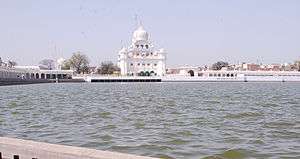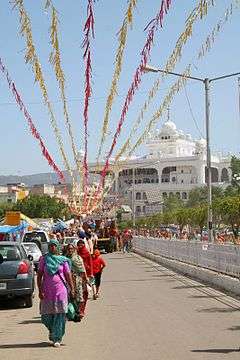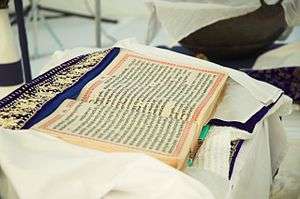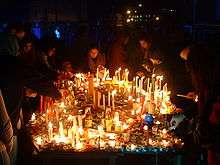List of Sikh festivals
This is the list of festivals observed by the followers of Sikh religion.
Sikh festival
| Festival | Date Observed [from year to year dates vary] | Description |
|---|---|---|
| Maghi | January 14 |  Gurudwara Muktsar Sahib |
| Parkash Utsav Dasveh Patshah | January 31 | This festival's name, when translated, means the birth celebration of the 10th Divine Light, or Divine Knowledges.It commemorates the birth of Guru Gobind Singh, the tenth Sikh guru. The festival is one of the most widely celebrated event by Sikhs. |
| Holla Mohalla | March 17 |  A young Sikh performer at Holla Mohalla |
| Vaisakhi | April 13 |  |
| Martyrdom of Guru Arjan | June 16 |  Panj Pyare, leading a procession of nagar kirtan marking the Shaheedi divas (martyrdom) |
| Phalia Prakash Sri Guru Granth Sahib Ji | September 1 |  A copy of Guru Granth Sahib, the eternal Sikh Guru |
| Bandi Chhor Divas(Diwali) | November 9 |  Diwali celebrations in United Kingdom. |
| Guru Nanak Gurpurab | November 22 | On this day Guru Nanak was born in Nanakana Sahib,now situated in Pakistan. Every year Sikhs celebrate this day with large scale gatherings. Candles, divas and lights are lit in Gurdwaras, in the honour of Guru along with fireworks. The birthday celebration usually lasts three days. Generally two days before the birthday, Akhand Path (forty-eight-hour non-stop reading of Guru Granth Sahib) is held in the Gurdwara. One day before the birthday, a procession is organized which is led by the Panj Pyares (Five Beloved Ones) and the Palki (Palanquin) of Sri Guru Granth Sahib and followed by teams of Ragis singing hymns, brass bands playing different tunes and devotees singing the chorus. Gurdwara Nankana Sahib, Pakistan A fireworks show celebrating the Birth of Guru Nanak in India.  |
| Martyrdom of Guru Tegh Bahadur | November 22 | On this day Guru Tegh Bahadur was martyred when he refused to convert to Islam.  Gurdwara Sis Ganj Sahib where the Guru was martyred The Mughal Emperor, Aurangzeb cherished the ambition of converting India into a land of Islam. His experiment was first carried out in Kashmir. The viceroy of Kashmir carried out the policy vigorously and set about converting non-Muslims by force.[2][3] A group of Kashmiri Pandits (Kashmiri Hindu Brahmins), approached Guru Tegh Bahadur and asked for his help. They, on the advice of the Guru, told the Mughal authorities that they would willingly embrace Islam if Guru Tegh Bahadur, did the same.[2][3] Gurudwara Sisganj Sahib in Anandpur Sahib where the head of guru was brought and cremated in defiance of Mughals Orders of the arrest of the Guru were issued by Aurangzeb and the Guru was arrested at a place called Malikhpur near Anandpur after he had departed from Anandpur for Delhi. He was arrested, along with some of his followers and sent to Sirhind the following day. The Governor ordered him to be detained in Bassi Pathana and reported the news to Delhi. His arrest was made in July 1675 and he was kept in custody for over three months. He was then cast in an iron cage and taken to Delhi in November 1675. The Guru was put in chains and ordered to be tortured until he would accept Islam. When he could not be persuaded to abandon his faith to save himself from persecution, he was asked to perform some miracles to prove his divinity. On his refusal, Guru Tegh Bahadur was beheaded in public at Chandni Chowk on 11 November 1675. Guru Ji is also known as "Hind Di Chadar" i.e. "the shield of India", suggesting that to save Hinduism, Guru Ji gave his life. |
Other Sikh Festivals
There are some other (around 45) festivals that are celebrated at a much smaller scale with some being centred in particular regions or towns that are not included in the above list. Thoses include Parkash Utsavs (Birth anniversaries of the other 8 Sikh gurus), Gurgadi Divas (passing of guruship), Jyotijot Divas (death anniversaries of other Sikh gurus), Basant Festival of kites which is celebrated in Chheharta Sahib Gurdwara in the village of Wadali where Sri Guru Hargobind Ji was born in 1595, to celebrate the birth and [4] many other such festivals. All Sikh festival include celebrating by gathering at Gurdwara, paying obeisance to the Guru Granth Sahib and listening to Gurbani, Kirtan and reciting Paath.
However, there are quite a few other local fairs which are historically important to the Sikhs and attract crowds in hundreds of thousands and last two to three days. The most important of these are:
- The Martyrdom of both the younger Sahibzadas of Guru Gobind Singh at Fatehgarh Sahib.
- The Battle of Chamkaur and the Martyrdom of both elder Sahibzadas of Guru Gobind Singh.
- The Martyrdom of the forty followers("Forty Immortals") of Guru Gobind Singh who had previously deserted him, fought bravely against overwhelming Mughal army forces in Muktsar. Guru Gobind Singh blessed them as having achieved liberation. Mela Maghi commemorates this event and an annual fair is held in Sri Muktsar Sahib town.
